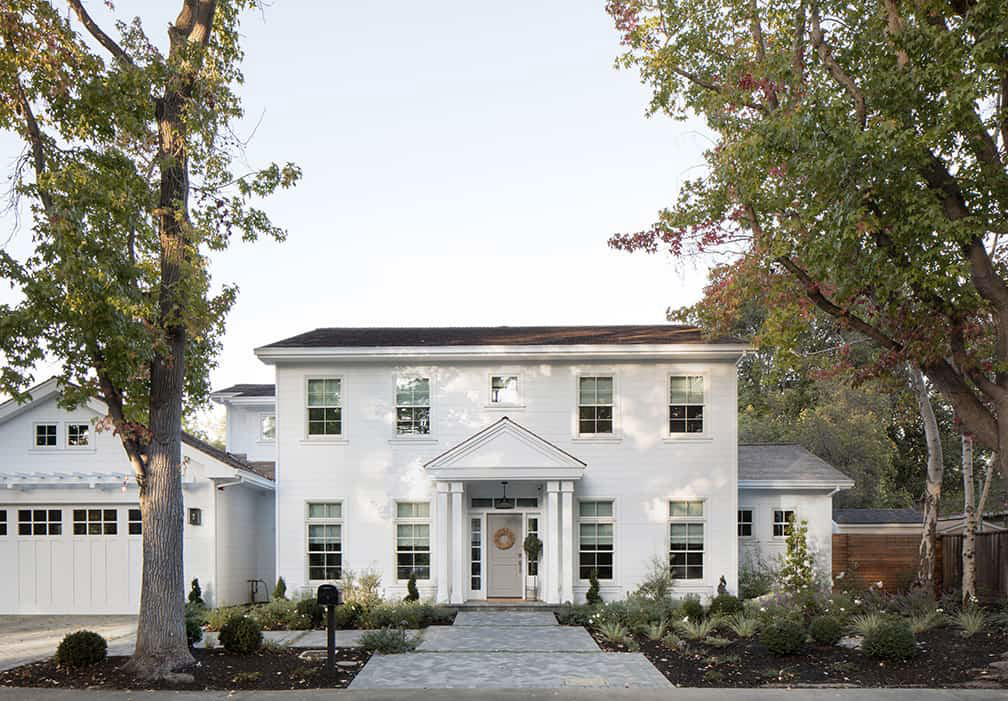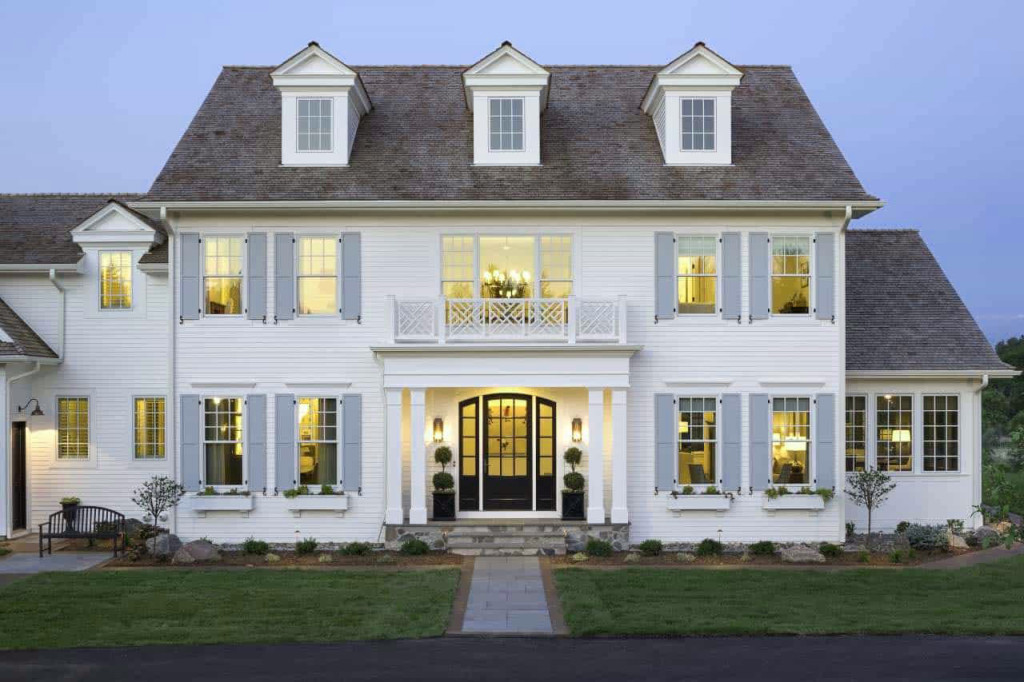Introduction – Colonial House Design
Brief Overview
Colonial house design is an expansive term that envelops various architectural styles that were famous in the American settlements during the 17th and 18th centuries. These homes were impacted by the design customs of the European pioneers who came to America, as need might arise and difficulties of residing in another land.
Colonial houses are regularly described by their evenness, balance, and downplayed style. They are frequently made of wood, block, or stone, and component peak rooftops, dormer windows, and focal passages. Numerous frontier homes additionally have yards, screens, and other embellishing components.
Significance of Colonial Architecture
Colonial architecture is huge in light of the fact that it mirrors the early history and culture of the US. Provincial homes were worked by individuals from varying backgrounds, and they address the different scope of impacts that molded American culture. Colonial architecture is likewise valued for its excellence and craftsmanship.
Historical Roots – Colonial House Design
Colonial Architecture Origins
The starting points of colonial architecture can be followed back to the architectural customs of Europe. The principal European pioneers in America carried with them the structure styles that were famous in their nations of origin. After some time, these styles advanced to adjust to the American environment and scene.
Influences on Colonial House Design
A number of factors influenced the design of colonial houses. One important factor was the climate. The cold winters and hot summers of the American Northeast required homes to be well-insulated and well-ventilated. The abundance of wood in the colonies also played a role in shaping colonial architecture. Many colonial homes were built with wood siding and shingles.
Another important factor that influenced colonial house design was the availability of materials. In the early colonies, brick and stone were scarce materials. As a result, many colonial homes were built with wood. However, as the colonies became more prosperous, brick and stone became more widely available.
Evolution Over Time
Colonial house design developed over the long run as the states developed and changed. In the early provinces, homes were normally basic and utilitarian. Nonetheless, as the states turned out to be more prosperous, pioneers started to fabricate bigger and more intricate homes. Pilgrim design likewise developed to mirror the changing preferences and styles of the time.

Types of Colonial Houses
There are various sorts of colonial house designs , each with its own interesting qualities. The absolute most normal kinds of colonial houses include:
- New England Colonial: New England colonial houses are typically characterized by their rectangular shape, gable roof, and central doorway. They are often made of wood with clapboard siding.
- Spanish Colonial: Spanish colonial houses are typically characterized by their stucco walls, red tile roofs, and arched doorways. They often have courtyards and patios.
- Dutch Colonial: Dutch colonial houses are typically characterized by their gambrel roofs, which slope down on each side to form a second roofline. They often have brick siding and Dutch doors, which are split in the middle horizontally.
- Georgian Colonial: Georgian colonial houses are typically characterized by their symmetrical façade, columned entrances, and Palladian windows. They are frequently made of block or stone.
- French Colonial: French colonial houses are typically characterized by their hipped roofs, dormer windows, and French doors. They are often made of brick or stucco.
Key Architectural Elements – Colonial House Design
Symmetry and Balance
One of the key architectural elements of colonial house design is symmetry and balance. Colonial homes are typically symmetrical along a central axis, with the front door centered in the façade and the windows evenly spaced on either side. This balance makes a feeling of request and congruity.
Gable Roofs
Another key architectural element of colonial house design is the gable roof. Gable roofs are pitched roofs with two sloping sides that meet at a ridge at the top. Gable roofs are practical and aesthetically pleasing. They shed water and snow effectively, and they also create a sense of height and drama.
Dormer Windows
Dormer windows are windows that project from a sloping roof. Dormer windows are often used to add light and ventilation to attic spaces. They can also be used to create additional living space.
Chimneys and Fireplaces
Chimneys and fireplaces were fundamental highlights of pioneer homes. Chimney stacks were utilized to vent smoke from chimneys, which were utilized for warming and cooking. Colonial chimneys are frequently made of block or stone, and they can be very elaborate.
Central Hallway
Many colonial homes have a focal passage that goes through the focal point of the house. The focal passage was the principal flow space in the house, and it frequently prompted the primary rooms, like the parlor, lounge area, and kitchen.
Building Materials – Colonial House Design
Traditional Materials
The most well-known building materials utilized in pioneer houses were wood, block, and stone. Wood was the most plentiful material, and outlining the walls and top of most pioneer homes was utilized. Block and stone were more costly materials, however they were frequently utilized for the establishment and outside of additional intricate homes.
Modern Adaptations
Today, colonial houses are frequently worked with various current materials, for example, concrete, vinyl siding, and metal material. These materials are sturdy and low-support, settling on them a decent decision for present day mortgage holders. In any case, numerous mortgage holders actually decide to utilize conventional materials, like wood and block, to keep up with the validness of their provincial homes.
Sustainable Options
There are a number of sustainable building materials that can be used to build or renovate a colonial home. Some popular options include:
- Recycled wood: Recycled wood is a sustainable alternative to new wood. It is produced using recovered wood that has been cleaned and handled for reuse.
- Bamboo: Bamboo is a quickly developing and inexhaustible asset that can be utilized to make an assortment of building materials, including ground surface, siding, and material.
- Cork: Cork is a sustainable material that can be used to insulate walls and floors. It is also a good choice for flooring because it is soft and quiet underfoot.
Interior Design – Colonial House Design
Colonial Interior Aesthetics
Colonial interior design is typically characterized by its simplicity and elegance. Colonial homes are often decorated with neutral colors and natural materials, such as wood and brick. Colonial furniture is typically made of wood, and it is often simple and functional.
Furniture and Decor Some common pieces of colonial furniture include:
- Windsor chairs: Windsor chairs are a type of wooden chair with a distinctive back design. They are often found in colonial dining rooms and kitchens.
- Four-poster beds: Four-poster beds are large beds with four posts at the corners. They were popular in colonial bedrooms because they provided a sense of privacy and warmth.
- Dressers: Dressers are chests of drawers that are used to store clothing and other belongings. They were often found in colonial bedrooms and dressing rooms.
Some common colonial décor items include:
- Samplers: Samplers are pieces of needlework that were made by young girls and women in colonial America. They are often framed and displayed in colonial homes.
- Portraits: Portraits of family members and other important figures were often displayed in colonial homes.
- Mirrors: Mirrors were a luxury item in colonial America, and they were often displayed in prominent places in colonial homes.
Color Schemes
Colonial homes were frequently enriched with unbiased tones, like white, beige, and dim. These varieties made a feeling of quiet and request. Nonetheless, pilgrim homes could likewise be embellished with splendid tones, like red, green, and blue. These varieties were frequently used to complement building highlights or to make a bubbly environment.
Flooring and Ceilings
Flooring in colonial homes was typically made of wood. Wide-plank wood floors were popular in colonial living rooms and dining rooms. Pine floorboards were often used in colonial kitchens and bedrooms.
Ceilings in colonial homes were typically made of wood or plaster. Wood ceilings were often left exposed, while plaster ceilings were often whitewashed.

Landscaping and Gardens
Colonial Garden Layouts
Colonial gardens were typically laid out in a formal manner. They were often divided into symmetrical plots with geometric shapes. Colonial gardens often featured a variety of plants, including flowers, vegetables, and herbs.
Role of Gardens in Colonial Homes
Colonial gardens assumed a significant part in the existences of pilgrim Americans. They gave a wellspring of food, medication, and magnificence. Pilgrim gardens were likewise utilized for diversion and get-togethers.
Maintenance and Preservation
Challenges in Preserving Colonial Houses
Colonial houses are often over 100 years old, and they can require significant maintenance and preservation. Some of the challenges in preserving colonial houses include:
- Wood rot: Wood rot is a common problem in colonial houses. Wood is powerless to spoil when it is presented to dampness.
- Structural damage: Colonial houses may have structural damage caused by age, weather, or pests.
- Lead paint: Lead paint was commonly used in colonial houses. Lead paint is toxic and can be harmful to human health.
Tips for Restoration
Assuming you’re thinking about the rebuilding of your Colonial home, there are numerous approaches to ensuring that the reclamation is done accurately. These are a few supportive tips:
- Hire a qualified contractor who has experience restoring colonial houses.
- Use traditional materials and construction methods whenever possible.
- Be respectful of the original features of the house.
- Make any changes in a way that is compatible with the overall style of the house.
Modern Amenities Integration
It is possible to integrate modern amenities into a colonial house without sacrificing the authenticity of the home. Here are a few ideas:
- Install central heating and air conditioning.
- Update the electrical wiring and plumbing.
- Add a modern kitchen and bathroom.
- Install energy-efficient windows and doors.
- Add insulation to the walls and attic.
Conclusion
Colonial house design is a rich and varied tradition. Colonial houses are beautiful, practical, and timeless. If you are considering buying or renovating a colonial house, there are a number of things you can do to ensure that your home is well-maintained and preserved.
FAQS What Defines Colonial House Design?
Colonial house design is characterized by several key features, including a symmetrical facade, a gable roof, brick or wood siding, and evenly spaced windows. The style is inspired by the architecture of early American settlers and reflects the simplicity of that era.
What Types of Colonial Houses Exist?
There are several distinct subtypes of colonial houses, such as:
Colonial Revival: A popular style in the early 20th century, it harkens back to the colonial period with added modern conveniences.
Georgian Colonial: Known for its strict symmetry, elaborate molding, and large, rectangular shape.
Dutch Colonial: Recognizable by its gambrel roof and cozy, cottage-like feel.
Saltbox Colonial: Named for its resemblance to a wooden saltbox container, featuring a sloping roof and asymmetrical design.
Federal Colonial: Characterized by its decorative details, tall windows, and neoclassical elements.
What Materials Are Used in Colonial House Design?
Colonial houses typically feature wood or brick siding. However, modern versions may incorporate vinyl siding for easier maintenance. Roofs are often made of shingles or thatch, depending on

